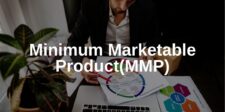Launching early is great, until your product lands with a thud. The Minimum Lovable Product, or MLP, flips the usual “just ship it” mindset by focusing on creating something small, sharp, and genuinely likable right out of the gate.
In this guide, you’ll learn what an MLP is, how it compares to an MVP, and how to build a product people actually care about.
What Is a Minimum Lovable Product (MLP)?
A Minimum Lovable Product is the smallest version of your product that users don’t just tolerate, they actually enjoy using. Unlike an MVP, which focuses on basic functionality to validate a concept, the MLP aims to deliver a focused solution with a hint of delight baked in.
It’s not about bells and whistles; it’s about shipping something small that users care about enough to use, share, and stick with. This approach encourages emotional engagement from the start, creating better retention and feedback loops early in the product life cycle.
MLPs push teams to identify what truly matters to their users, not just what’s technically viable. That might mean a cleaner UI, a smoother onboarding flow, or a quirky brand voice that resonates.
You still keep things lean, but you sharpen your delivery so the first version actually connects with the humans behind the clicks. To get there, you need to zoom in on what makes a product lovable without blowing your scope.
Key traits of a Minimum Lovable Product:
- Solves one specific problem exceptionally well: Your MLP doesn’t try to do everything, it does one thing with clarity and intention that users immediately recognize.
- Delivers a hint of personality or polish: Whether it’s smooth UX, thoughtful copy, or a tiny surprise moment, an MLP feels like someone gave a damn when they built it.
- Triggers emotional response early: The product experience sparks interest, joy, or relief, something strong enough to make users think, “This is it.”
Build Your Minimum Lovable Product in 6 Strategic Steps
An MLP doesn’t happen by accident, it takes smart decisions, focused scoping, and a serious commitment to user experience. These six steps will help you create something lean that users actually want to use, not just test and forget.
1. Pinpoint a Specific, Painful Problem
Lovable products don’t start with features, they start with a real, frustrating problem that users feel every single day. If your product idea doesn’t solve something clear, urgent, and painful, there’s no emotional hook to build around.
This isn’t about brainstorming, it’s about listening hard to what users complain about, workaround, or hate wasting time on.
Use interviews, user reviews, support logs, and behavior data to uncover pain points that are both frequent and costly. Skip the nice-to-haves and aim for problems that create friction or anxiety when unsolved.
Once you’ve nailed that problem, it becomes the north star for every design, feature, and decision ahead.
2. Focus Ruthlessly on Core Functionality
Don’t try to impress users with a giant feature list, win them over by doing one thing exceptionally well.
Strip your scope down to the most direct, effective way to solve the problem you identified. Any feature that doesn’t move that needle is noise and should wait.
The goal is to get users from problem to resolution with as little friction as possible. A clear, focused product builds trust faster than a clunky, feature-heavy one that tries to do everything at once.
Your MLP should feel clean, direct, and sharp, not half-built or confusing.
3. Add a Small Layer of Delight
Lovable doesn’t mean bloated, it means intentional, human, and sometimes a little surprising. Add one thoughtful touch that makes your product feel like it was built with care, not just code.
This could be a fun loading screen, a clever empty state, or a moment of clarity that makes the user say, “Finally!”
These micro-moments create a sense of connection between the product and the person using it. It’s not about wowing everyone, it’s about giving the right user one reason to smile, trust, or feel understood.
That emotional spark is what separates an MLP from a bare-bones MVP.
4. Build With Real User Feedback, Not Assumptions
You’re not your user. What you think is lovable might come across as confusing, unnecessary, or irrelevant in practice. The only way to know what actually resonates is to bring users into the process early, before you get attached to your own ideas.
Start with lightweight prototypes or clickable demos, then listen closely to reactions. Look for body language, hesitation, or unexpected excitement, those are signals worth chasing. Great MLPs are shaped by feedback loops that start before the first line of code is written.
5. Keep Your Launch Small and Focused
A Minimum Lovable Product is built for tight feedback, not global fanfare. Share it with a curated group of early adopters who live with the problem you’re solving and care enough to give real, honest feedback. The tighter your audience, the faster your learning curve.
Avoid going wide too soon, or you’ll drown in noise and miss out on high-quality insights. A focused release gives you space to observe behavior, adjust quickly, and reinforce what users love most. That intimacy is where real momentum starts, no press release required.
6. Watch Behavior, Not Just Words
People say nice things about decent products all the time, but lovable products get used, shared, and recommended. Don’t rely only on surveys or testimonials after launch. Watch how users actually behave: where they drop off, where they return, and how often they complete key actions.
Look at usage patterns, activation rates, and retention over time to understand whether the product is clicking emotionally. If people are ghosting after one try, you’ve got more work to do. Real love shows up in behavior, not compliments.
MLP vs. MVP: What’s the Difference, Really?
While both approaches aim to build lean and test early, the Minimum Lovable Product (MLP) and Minimum Viable Product (MVP) take fundamentally different paths to get there. Here’s a side-by-side look at how they stack up—and why it matters.
| Minimum Viable Product (MVP) | Minimum Lovable Product (MLP) |
|---|---|
| Primary Goal: Validate the core idea with minimal effort | Primary Goal: Deliver an emotionally engaging experience early |
| User Focus: Usability and functionality | User Focus: Usability plus emotional connection |
| Feature Set: Bare minimum to test hypotheses | Feature Set: Focused core features with intentional polish |
| Emotional Engagement: Low—functional, but often uninspiring | Emotional Engagement: High—built to spark delight, trust, or interest |
| Target Users: Early adopters, testers | Target Users: Early fans, champions, and word-of-mouth drivers |
| Success Signal: Confirmation that the idea “works” | Success Signal: Signs users love it—usage, shares, feedback loops |
| Common Outcome: “It works, but needs improvement” | Common Outcome: “I love this and want more” |
Primary Goal
An MVP’s purpose is simple: prove that your product idea solves a problem and that users are willing to engage with it at all. It’s about validation—getting just enough out there to collect early data and decide whether to continue, pivot, or stop.
The MLP, however, shifts the goal from just proving something works to proving something resonates. It’s not only about functionality; it’s about building the first version users can care about.
MLPs aim to generate early traction and emotional investment, not just technical confirmation.
User Focus
In an MVP, the user is often a means to an end—they’re there to test assumptions, find bugs, or flag broken flows. The experience doesn’t need to impress, just function. An MLP flips that mindset by seeing users as early fans, not testers.
It treats every interaction as a chance to build trust and affinity. The goal is to create an experience that makes users feel understood—not just functionally served.
Feature Set
MVPs are famously bare-bones. The idea is to launch with just enough to test one or two core hypotheses. The result often feels incomplete or rough, and that’s by design. MLPs are still minimal, but they’re intentional.
Every included feature must do one of two things: solve a core problem, or elevate the experience. There’s no room for filler—but also no excuse for neglecting the details that make the product feel coherent and considered.
Emotional Engagement
MVPs tend to fall into the “meh” zone—they might work, but they don’t spark any feeling. That’s fine for validation, but it won’t drive retention. MLPs aim to trigger an emotional reaction early.
It might be relief (“Finally, someone solved this”), delight (“This is actually fun”), or trust (“This just gets me”). These small emotional cues are often the difference between something people test and something they keep using.
Target Users
The MVP crowd is typically tolerant of glitches—they’re testers, developers, internal teams, or early adopters who care more about the concept than the polish. MLPs, by contrast, target emotionally-aligned users who are likely to become loyal customers or brand evangelists.
These people are harder to impress—but more valuable when won over. They’re the ones who share, review, and stick around because the product means something to them.
Success Signal
Success for an MVP might look like a working prototype, a few positive survey results, or validation of a core assumption. It’s measured in data points and learning, not user enthusiasm.
For an MLP, success looks like usage—people coming back, completing key actions, and referring others. It’s about behavior over opinion. When users show signs of genuine affection (not just tolerance), you know you’ve hit something meaningful.
Common Outcome
Launching an MVP usually leads to a list of fixes: bugs, confusing flows, missing features. It highlights what’s broken or what needs to be built next. Launching an MLP often gives you a different kind of feedback—what’s loved, what stands out, and what users wish there was more of.
You’re not just hearing what’s wrong; you’re learning what to double down on. That’s a stronger foundation for building something people want to keep using—and paying for.
Read more: Minimum Marketable Product
Why Building an MLP Sets You Up to Win
A Minimum Lovable Product isn’t just a nice idea, it’s a smarter way to launch. When done right, it sets your product apart early, builds stronger user bonds, and gives your team a sharper focus from day one.
Faster, Sharper Product Validation: An MLP gets real reactions, not vague interest. Users either love it or they don’t, and that honesty helps you validate your concept quickly. Because it’s emotionally engaging, you’ll get clearer signals about what’s working and what’s not.
Higher Retention from Day One: When a product feels thoughtful and useful from the start, people stick around. MLPs create early loyalty by solving a real problem and making users feel like it was built for them.
Better Quality Feedback Loops: People don’t give useful feedback on things they don’t care about. When users actually enjoy the product, they’re more likely to share honest, helpful insights. That means you get deeper, more actionable data with less prompting.
Stronger Word-of-Mouth and Organic Growth: Users talk about things they love, not things they tolerate. When you hit the emotional mark, people naturally share it with friends, colleagues, or their online communities.
Clearer Internal Focus and Team Alignment: MLPs force your team to get specific about what matters most. Instead of spreading thin across features, you align around delivering one amazing experience.
When Should You Choose a Minimum Lovable Product?
An MLP isn’t always the default, but in the right context, it can dramatically improve product traction and user engagement. Below are specific situations where choosing an MLP gives you a strategic edge from the start.
When You’re Competing in a Crowded Market
In saturated markets, being functional isn’t enough, your product has to stand out emotionally. An MLP helps you cut through the noise by offering a smaller but more thoughtful experience users remember.
It focuses your team on delivering a product that creates affinity, not just access. That emotional hook is what gets users to try over a dozen similar alternatives.
When User Retention Matters More Than Raw Acquisition
If your business model relies on long-term use, referrals, or repeat engagement, retention needs to be a top priority. MLPs give users a reason to come back, because the product feels valuable and human from day one.
Unlike bare MVPs that may check boxes but lack spark, an MLP earns trust early. That trust translates into usage, loyalty, and eventually, revenue.
When You Need Useful Feedback, Fast
Early-stage feedback only matters if it’s honest, specific, and tied to real user behavior. MLPs encourage users to care enough to provide meaningful responses, not just surface-level opinions.
Instead of vague praise or silence, you’ll hear what delighted, confused, or frustrated them. That type of feedback sharpens product direction far more effectively than data from disengaged testers.
When Your Brand Experience Is a Competitive Advantage
Some products compete not just on what they do, but how they feel. If your brand tone, UX, or design is a core part of your value, MLP thinking helps you deliver that from version one. It ensures the emotional layer of your product is baked in, not tacked on later.
For companies betting on customer experience, an MLP sets the tone early and earns loyalty faster.
What Actually Holds Teams Back From Building MLPs
One major blocker is organizational mindset. Many teams operate under short-term pressure to show results fast, especially in early funding stages or when KPIs are tied to volume over depth.
In that environment, “lovable” can sound like a luxury, even when it could mean faster traction. Leaders often default to minimum viable because it feels safer, easier to measure, and quicker to explain to stakeholders.
There’s also a cultural disconnect between product, design, and engineering teams. Without shared clarity on what makes a product lovable, each department may prioritize different things, speed, usability, or visual polish, and struggle to align.
Without strong cross-functional trust and a user-centered strategy, teams fall back on what’s safe: shipping something basic and hoping users will stick around. The problem is, most won’t.
How Teams Can Stop Playing It Safe and Start Building Better
- Redefine what success looks like: Shift your metrics away from shipping velocity and feature count. Start measuring retention, engagement, and how users actually feel about the product.
- Build alignment around one clear user problem: Make sure everyone, from design to engineering, agrees on the specific pain point you’re solving. Lovability comes from clarity, not excess.
- Involve users early and often: Collect feedback before you write code. Use interviews and lightweight prototypes to test how much users actually care.
- Encourage thoughtful scope, not feature bloat: Focus on the smallest solution that delivers relief and delight. Avoid tacking on extras that dilute the experience.
- Create space for emotional design: Support UX and brand decisions that connect with users beyond functionality. Small touches go a long way when they’re intentional.
- Back your team with leadership support: Leaders should give teams permission to take creative risks and prioritize depth over speed. Without that backing, teams will always default to “just good enough.”
Final Take: Build Small, Win Big With an MLP
A Minimum Lovable Product helps you cut through the noise by solving one real problem with clarity, purpose, and a touch of personality. It’s not about building more, it’s about building better, faster, and with intention.
When teams prioritize connection over complexity, they create products people actually care about. MLP thinking turns early launches into lasting traction.
Frequently Asked Questions
How long should it take to build a Minimum Lovable Product?
A Minimum Lovable Product should take weeks, not months, to build. The focus is on solving one clear problem well with just enough polish to create a connection, so tight timelines are realistic when scope and purpose are clear.
Can a Minimum Lovable Product be used for B2B products?
Yes, a Minimum Lovable Product works in B2B if it delivers immediate, visible value to a specific user group. Even enterprise users respond positively to intuitive design, clarity, and products that feel made for their real-world pain points.
Does a Minimum Lovable Product need to include branding?
Brand elements can help, but only if they support usability and emotional connection. A thoughtful tone, visual consistency, or helpful microcopy can make a product feel personal, without requiring a full visual identity from day one.
Related:
- Brand Extensions vs. Sub-Brands: Choosing the Right Strategy for Growth
- Product-Market Fit: Unlock Growth with These Essentials
- From Spark to Success: How to Transform Your Idea into an Impactful Invention

We empower people to succeed through information and essential services. Do you need help with something? Contact Us.
Want a heads-up once a week whenever a new article drops?







